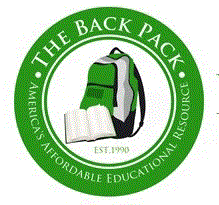|
Phonics
is the foundation of reading, which is the foundation of learning.
Phonics is usually taught from kindergarten through around 3rd
grade and obviously overlaps with spelling. A comprehensive
phonics program needs to be customized based on your child's
indivdual level and abilities.
Traditional spelling texts (which are usually
designed for grades 1-6) will include basic spelling lists as
well as a variety of other skills
like word usage, dictionary skills, prefixes and suffixes,
definitions, writing etc.
Vocabulary building programs are usually designed for
grades 7-12 and are often workbooks which will include a variety
of exercises.
Many literature books include
vacabulary exercises at the end of each chapter.
History/Social
Studies
Standard
grade level
history text for grades 1-6 usually covers a number of topics like American
history, geography, world history, social
studies etc. No matter which one you choose for what ever grade level you're
teaching, just know that you'll cover that same material on a higher level
again in grades 7 -12.
In these middle to high school grades, most traditional
publishers will have individual texts for American history, World
history, Geography, Government, Economics,
Civics and state history book. You can either use
these 7-12 grade texts by grade level or you can teach whatever
you want whenever you want. Always keep your state home school law
in mind.
The hands-on approach, unit study method, or reading so
called "real" books can work well, especially in the elementary
grades. We encourage you to supplement this more random teaching
style with the standard grade level texts mentioned above to help
prepare you child for standardized tests that many states require. Your child may use these traditional
texts as readers or in a read aloud/discussion setting.
We have also found that
most home school parents prefer the traditional text when their children reach the upper grades (7-12) to insure their child doesn't have gaps
which is often a concern of parents with middle to high
school age students who are preparing for college prep tests.
Science
Science can be taught many different ways in all grades- unit studies, hands-on
approach, traditional text or in any combination.
Most textbook publishers address the 3 sciences (life, earth and
physical) in their 1st through 6th grade text books. Some may also include
health.
7th grade science texts usually cover either "general"
science (which is usually a combination of the 3 sciences mentioned
before) or life science.
8th grade usually covers either "general" science or
earth science.
9th grade is usually physical science.
10th through 12th grades are usually devoted to biology or
chemistry.
Obviously, you can teach whatever you choose, but be sure
to refer to your state's home school guidelines when necessary.
|
|
Once your child
learns to read there are obviously a million things from which to choose. In the
early grades, I suggest you use phonics readers which usually include only
a limited number of sight words, are vocabulary controlled, and will supplement
any phonics program you may have chosen.
Traditional reading programs are most often designed for grades 1-6
and come in a variety of formats. Literature is usually taught in grades
6-12. We recommend that you invest in a literature library. Find a publisher you
like and invest in a "set" (student book & teacher edition) for each grade
(7-12). This will give you many years of use and your
student an overall understanding and appreciation of literature. You can easily
correlating your literature with your history. For example if you're studying
American history - also study American literature.
English
Grammar and Composition
There are many
ways to teach English grammar and composition. Here are two:
1. Your child (any grade) can study English by using a
traditional text which will teach both grammar and composition. Very often they
also cover Spelling, Vocabulary, Study Skills or Usage and Mechnics. We
have found that because so much of the information presented in a traditional
English text is duplicated from year to year, it is not always necessary for you
to buy an English program every year. Instead, choose a publisher you like and
buy a few elementary level books, a middle school book and a few high school
books (especially grade 12 as it usually contains everything). Use each book for
more than one school year instead of trying to cram in a whole English book
every year!
2. Another method of teaching English is to teach using two books- one
that teaches grammar to be combined with a product that teaches composition.
Mathematics
You'll find that all math books for
grades K-6 usually contain pretty much the same basic concepts for the
particular grade level. Choose the one that best suits your child's
learning style. Workbooks to accompany your student's textbook are very helpful
for review and reinforcement of math concepts. After completing grades K-6 you may then move on to 7th &
8th grade math books which should pull together and build upon all the
basic skills learned in previous grades. Consumer and Business math can be
taught any time you want, but most publishers design them for use in middle to
high school. Then move on to Algebra, Geometry (usually
touched on in the preceding grades), Advanced
Math, Calculus and Physics.
We highly recommend that you always purchase Teacher
Editions, Teacher Manuals or answer
keys to accompany you math textbook because they are a time saver and have tips etc. on teaching concepts. Solution Manuals
are very
helpful when you are teaching the higher maths as they give you the answers to
the problems in your student's text worked out step by step.
We hope this information
was helpful. Please feel free to call if you have questions.
252 244 0728
888 268 5087
Copyright 2020
The Back Pack
|

